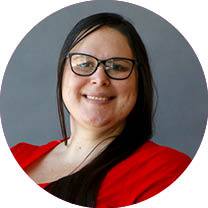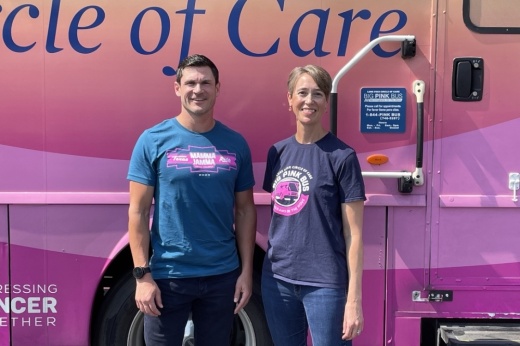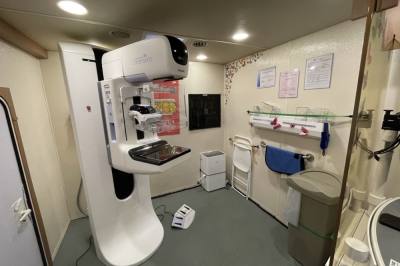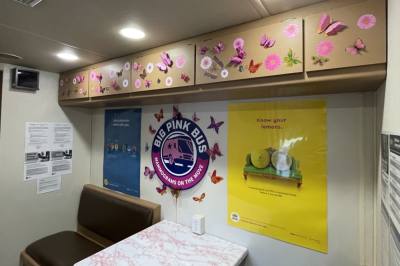Lone Star Circle of Care CEO Jon Calvin and Big Pink Bus Program Director Rebecca Sorensen spoke with Community Impact about how the Big Pink Bus got its start, its response in the community and the need for early detection in the fight against breast cancer. This interview was edited for length, clarity and style.
How did the Big Pink Bus originate?
Calvin: It actually started with the Ascension Seton hospital system. They operated the bus for a period of time, then it was basically idle and out of service due to various challenges. After that, a group of leaders within the Austin area decided to get together. The group, Addressing Cancer Together coalition, identified that there’s some health disparities existing in Central Texas. We wanted to see how we could tackle some of the cancers, especially ones uninsured patients are facing today. One of the ideas early on was to go after breast cancer. We decided there was an opportunity—since the bus’s infrastructure already existed—to put that asset back into the community. We participated in the coalition, and through that process Lone Star Circle of Care decided to step up and actually operate the bus.
How did you identify the need for breast cancer screenings?
Calvin: If you look at breast cancer screenings for the entire eligible population based on guidelines, uninsured adult screenings are lower than the overall average of someone who is commercially insured. Then, we looked at national averages, specifically during the pandemic, and saw that screening rates for breast cancer have gone down quite a bit. So just looking at the access to screenings for the uninsured, and then also looking at the more detailed picture based on race and ethnicity, there was an identified need to do more targeted outreach in the community. We thought this was a great mechanism to do so.
How does the bus operate on a daily basis?
Sorensen: We provide mammogram screenings only on the bus. The beginning part of that is finding patients. We have our own network of patients that we reach out to. We will reach out to patients who might be overdue for a mammogram or who have never had one before. We have a designated day the bus will be at a certain location, then the patients show up to the bus for their appointment. After the mammogram, we’ll reach out to them with results. We’ll assist them with additional appointments if they require additional appointments.
Calvin: Also, we partner with Austin Radiological Associates who actually do the readings and send the results back to us. If a patient ends up with a positive cancer diagnosis, we have a team that can help enroll that patient in any eligible programs.
What has the response been from the community?
Sorensen: People love the bus. They resonate with the bus, and a lot of people know the history of the bus. From both patients and regular community people, we get a lot of positive feedback. We also get a lot of requests from potential community partners about wanting to have the bus on-site. They’ve heard about it, and they think it would be great for their population.
Why is this service important?
Sorensen: It’s important because we provide accessibility and a little bit of convenience. This is something that might be available elsewhere, but we are bringing it to a place that [patients] are already familiar with and might already go to for other services.
Calvin: The other component is affordability. For patients at or below 100% of the federal poverty level, the mammogram is free, so that removes that barrier with costs. Then, it’s a very affordable rate going up the sliding fee scale.
What would you say to individuals who are hesitant about getting a mammogram and utilizing these services?
Sorensen: My message would be that it’s part of preventive health care. This is one service that is noninvasive. It doesn’t necessarily hurt to get it done. But if you get it done, and you find something, there’s a much greater probability that you can take care of it, resolve the issue and have a normal life than if you don’t take those preventive measures.
Who should be getting mammograms?
Sorensen: Anyone aged 40 and older, and typically anyone over age 50 is where we like to focus, but definitely all women in that age group regardless of health. Of course, if you have a health history of breast cancer, or a family history, it’s even more important. But even without a history, or a known history, it’s still important to get that regular preventive check.
Big Pink Bus
The mobile mammogram service is stationed adjacent to the Lone Star Circle of Care clinic, 2423 Williams Drive, Ste. 103, Georgetown. Other locations for the bus vary.
844-746-5287
www.lonestarcares.org/service/mobile-mammography-big-pink-bus
Hours: Mon.-Fri. 8 a.m.-4 p.m., closed Sat.-Sun.







